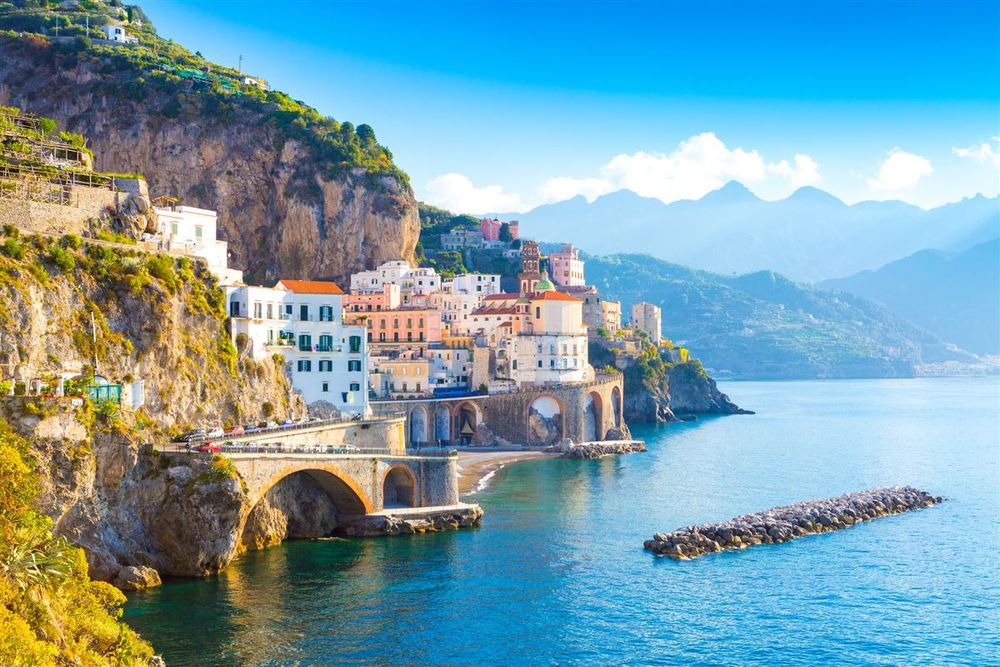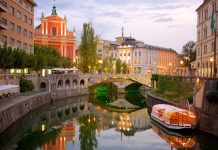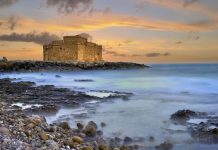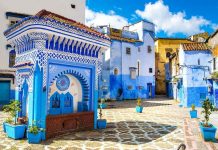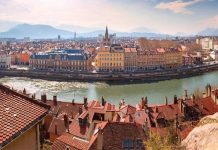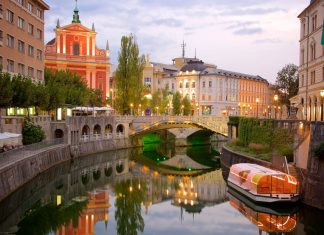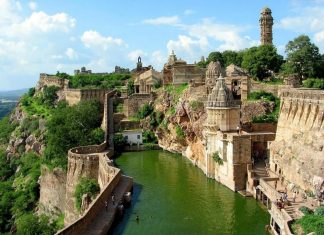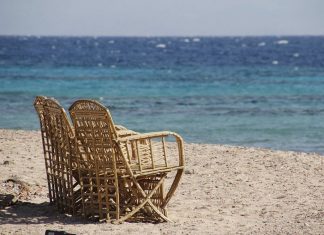Amalfi was once a seafaring Republic, rivalling Genoa, Venice and Pisa, from the ninth to the eleventh centuries. Today that competitiveness is exemplified by their participation in the Trophy of the Four Ancient Maritime Republics; a Regatta held each May in Venice.
Near the waterfront is the piazza del Duomo and the ninth century Cathedral of Saint Andreas (St. Andrew), whose remains are said to be buried in the crypt.
Extensively rebuilt last century and superbly maintained, this fine Cathedral reflects Amalfi’s original importance.
Starting at the Piazza del Duomo there is a pleasant scenic walk to the Molini Valley (Valley of the Mills) where paper mills were established in early times, introducing paper to Italy.
From the Piazza, alleys lead under white arches where curious little shops display ceramics ranging from huge jars to small jugs, all glowing with the appealing colours and designs of the region.
Exploring the Town
Near the sea there’s Flavio Gioia square with a moniment for compass’ inventor. From here you can see the remains of the arsenal in which were built the big galleys with 116 oars, the biggest of X – XI century. What you can see today, it’s just a part because it was destroyed by the sea storm in 1343. In Duomo square you can see the baroque fountain said ofS. Andrea or Popolobuilt in 1760. In front of the fountain you can see the cathedral. It’s composed by two basilicas: the lower is dedicated to the Assunta and then to the Crocefisso, about the VI century, it has a aisleless because the left nave is a part of the Paradise cloister and the right is just a storage; the high basilica, dedicated to S. Andrea has the transept and the crypt, it’s about 839 when it was violated by the prince Longobardo of Salerno,Sicardo.
CHIOSTRO PARADISO : The atrium in the Duomo also leads to the lovely Chiostro del Paradiso (Paradise Cloister) an elegant Arabian-style structure built in 1266-68 and contains the broken columns and statues, as well as sarcophagi, of a long-gone civilization. The aura here is definitely Moorish, with a whitewashed quadrangle of interlaced arches. Once they formed parts of columns and altars, a specialty of this region of Italy. The arches here created an evocative setting for concerts, both piano and vocal, held here on Friday nights from July trought September, with tickets costing 5.000L($3). The cloister is open daily 9am to 7pm and charges 5,000L ($3) for admission.
A minor attraction, good for that rainy day, is the Museo Civico, Piazza Municipio, which displays original manuscripts of theTavoliere Amalfitane.This was the maritime code that governed the entire Mediterranean until 1570. Some exhibits relate to Flavio Gioia, Amalfi’s most famous merchant adventurer. Amalfitani claim he invented the compass in the 12th century. The sun, the moon, the stars and Amalfi, locals used to say. What’s lefts from the attic of their once great power is preserved here. The museum is free and open Monday to Saturday 9am to 1pm.
For your most scenic walk in Amalfi, start at Piazza del Duomo and head up Via Genova. The classic stroll will take you to the Valle dei Mulini (the Valley of the public is said to have acquainted Italy with the use of paper). You’ll pass by fragrant gardens and scented citrus groves. If the subject interests you, you can learn more details about the industry at the Museo della Carta, Via Valle dei Mulini. It’s filled with antique presses and yellowing manuscripts from yesterday. It’s open Tuesday to Thursday and Saturday and Sunday 9am to 1pm. Admission is 2,000L ($1.20)
For the biggest attraction of all, head west to theEmerald Grotto.
Amalfiis a continuous call for tourists coming from all over the world, thristed of light and beauty, the place of an everlasting spring. In this heavenly nook, history and legend are weaved, and they create an inseparable whole. According to the tradition, Hercules, strenght pagan god, loved a nymph called Amalfi, but his love was short: she died and Hercules buried her in the most beautiful place of the world, and to immortalize her, he gave it her name. According to the history, it was founded after Constantino’s death; its origins came from Roman families.
The first news are about 533, during the Greek-Gothic war, with the victory of Narsete against Teia, Amalfi is under the rule of Bizantine Empire and it starts to be a part of Naples dukedom. In the VI century it’s a diocese. The bishop absolved religious services and he provided to town’s defence. Some aristocratics, landowners, deprived the bishop of his politic power. In 836 Sicardo, duke of Benevento, raided Amalfi, deporting the hinabitants to Salerno. In 839, Sicardo was killed, the Amalfitans rose, conquering a power and an autonomy that remained until the end of the XI century.
Amalfi became Republic in 850. Very often Amalfi united itself with Saracens and Ludovico II against Byzantines, that wanted restore the sovereignty of the Eastern Empire. Anyway, the alliance with Saracens was unstable and not lasting. In 915, after a very cruel battle, Saracens were defeated and definitely sent away of Reggio Calabria. For all the X century and the beginning of the XI century, the Amalfitans had a commercial increase and a very reliable economic welfare, taking a very important seat in the Mediterrian, the same seat that Pisa and Genova had later.
The richness of Amalfi was so big that Guglielmo Appulo wrote that only this town was so rich of gold, silver and everykind of fabrics and it was visited by Arabians, Sicilians, Africans and Indians.That because they had by Amalfitans the most ancient codifications, in the famous Tabula Amalphitana , that was the most accredited code of all the sailor nations of that time. It controlled the relations between ship’s master and sailor, between sailors and traders. The same Flavio Gioia’s legend, probabily lived at the beginning of the XIV century, gives to Amalfi the credit to have perfected the compass for the navigation and given materials about the first medieval nautical papers.
Ruler in spices field, in scents, in silk and precious carpets, in the X century Amalfi coined the Golden Coin, the golden and silver Tarì, that were used in Greek Empire, in Afric and in Longobardo principate. Amalfi’s development was so high thanks to its indipendence. In 1039 Guaimario V, prince of Salerno, took possession of amalfi’s dukedom, with the dominion of Salerno on Amalfi. Pressed by salerno, the amalfitans governed by Sergio IV, asked to Roberto il Guiscardo, in 1073, to help them. Salerno capitulated but amalfitans were conquered by Normans.
After Norman king’s death, in 1085, Amalfi tried to be free out of Normans power. In 1135 Amalfi suffered an horrible sack by Pisani, traitors, called for helping against Normans. It’s from now that begins Amalfi’s decadence. In 1343 a terrible sea-quake, described by Petrarca, hit the coast, the most part of the town was destroyed ( probabily with it also the Ducal Palace, mentioned in a document as Palatium Amalphitanum ), the fortifications were submerged, the shipyards, nautical equipements. Five years later, the famous plague of 1348, described by Boccaccio, completed the distruction among people.
Amalfi and all coast’s towns, that were beautiful places, populated and fortificated, rich of beautiful places, decorated by frescoes, marbles, columns, fountains, began modest towns, without richness, coming back to the traditional economy: fishing, local handicrafts, agriculture. Only at the end of nineteenth century, tourism gave to amalfi a very big increase, that now is the economic epicentre of all the coast that from Amalfi takes its name.
At the outset of amalfi, you can see S.franceso tower, said Tumulo ( Tumulus ) and theConvento dei Padri Minori Conventualiwhose building is traditionally attribuited to S.francesco. After Monastery’s suppression in 1087, you can see only the cloister that presents a lot of ogive archs. A very simple cornice complets the cloister: among the archs many little windows. Near the cloister there’s S.Antonio church, with a aisleless, a marmoreal altar and cinerary ruins in the sacresty. In the crypt you can see very interesting frescoes of thirteenth century. Here lie Father Domenico Girardelli da Muro’s mortal remains, that was the teacher of the blessed Bonaventura da Potenza whose mortal remains lie in S.Francesco On the mountain you can seethe ex-monastery of Benedictinesdedicated to S.Lorenzodel Piano and built by the doge Mansone III in 980 for the unmarried and virtuous women of the town.
In 1840 it was transformed in a cemetery. Here lie the mortal remains of the historic amalfitan Matteo Camera. In the monastery, today the seat ofthe municipality, you can see the text of the nautical system of Amalfi, the famous Tabula Civitatis Malphae. These tables are about the navigation: the freight’s price, captain and sailor’s duty, the indemnety of the assurances of naval trades, etc. And also some news about the social security as the society’s duty to take care of the sailor or member, ill or wounded. From here you can seethe Madonna of Pompei church, built in eighteenth century. The portal is decorated with stucco works of baroque and it introduces a aisleless decorated with stucco works. Very interesting is the tiled floor with majolica of eighteenth century.
Near the sea there’s Flavio Gioia square with a moniment for compass’ inventor. From here you can see the remains of the arsenal in which were built the big galleys with 116 oars, the biggest of X – XI century. What you can see today, it’s just a part because it was destroyed by the sea storm in 1343. In Duomo square you can see the baroque fountain said ofS. Andrea or Popolobuilt in 1760. In front of the fountain you can see the cathedral.
It’s composed by two basilicas: the lower is dedicated to the Assunta and then to the Crocefisso, about the VI century, it has a aisleless because the left nave is a part of the Paradise cloister and the right is just a storage; the high basilica, dedicated to S. Andrea has the transept and the crypt, it’s about 839 when it was violated by the prince Longobardo of Salerno, Sicardo. As said, the cathedral has S. Andrea’s name for a miracle: it was 27 of June in 1544 when to the horizon appeared Kaie-ad-din’s ships, knew as seas’ scourge. All the Amalfitans, full of fear, began to pray invoting S. Andrea’s helping. Suddenly all the coast was hit by a terrible storm and all the pirate ships were forced to go away. So the Amalfitans consecrated 27 of June as a holiday. During this day the bishop takes away the ampulla in which there’s the Manna.
To Proto’s family there’s a part of an old galley, picked up after the storm, on which are craved puttis, fauns and dragons. The miracle is also remembered in a painting of the Amalfitan painter Ottavio Eliani and it’s on the high altar. The cathedral was built in the IX century, it was extended in 990 when the doge Mansone III, obtained by Pope Giovanni XV the promotion and the elevation of this episcopal church to metropolitan dignity. It was rebuilt in 1203, adapted in 1526, 1556 and 1691 and still rebuilt in 1701-1731 for the archibishop Michele Bologna. After the ruin of the front on December 24th 1861, the atrium and the front too, were rebuilt by Enrico Alvino with Domenico Morelli, here a mosaic represents Christ on the throne among the symbol of the Evangelists. It’s about 1875 in a Norman and Campania’s style.
On the left there’s the bell-tower built between XII and XIII century. It was restored in 1768 and in 1934 was removed all the baroque style. About the end of XII century are the base zone and the two orders, the first with mullioned windows decorated by yellow tufa and the second by windows with three lights decorated by grey tufa. The bellfry has a central mainbody with 4 little towers covered by a roof with yellow and black tiles and everyone has three monowindows. Wonderful are the plaited archs supported by columns with stellar and flowered style. So, an imposing steircase with 57 steps, gives access to the covered atrium and supported by 26 columns.
On the right you can see cardinal’s bust of Pietro Capuano, the Assumption of Domenico Morelli and Paolo Vietri. There are also 4 frescoes about S. Andrea and the miraculous fishing made by Paolo Vietri. Very important is the bronze door with silver overhanging, built in Costantinopoli in 1066 by Simone of Siria payed by the Amalfitan Pantaleone of Mauro Comite. It’s divided in 24 panels with 4 pictures: Christ, the Madonna, S. Andrea and S. Pietro. Inside a baroque style, it’s bulit in latin cross style with 3 naves divided by 20 pillars and columns.
The coffer ceiling is golden with 4 big paintings by Andrea d’Aste, they represents S. Andrea’s flagellation, Manna’s miracle, the Crucifixion and the Saint on the cross. On the high altar S. Andrea’s crucifixion and on both sides two amboni decorated by mosaics about XII century. In the chapel, on the left, an old baptisimal basin of red pophyry coming from Paestum, at the end of the right nave there’s the bishop Andrea d’Acento’s sepulchre. From the left nave, a staircase leads to the crypt. On staircase’s walls there’s a painting about the Madonna col Bambino and S.S. Giovanni and Andrea and the Pietà. The crypt is divided by 2 naves. On the altar the bronze statue of S. Andrea given by Philiph III of Spain and marble statues of S. Lorenzo and S. Stefano by Pietro Bernini.
Under the altar are reserved S. Andrea’s relics, removed in 1208 by the Cardinal Pietro Capuano, back from the Holy Land. Saint’s bones issue an extraordinary substance, the Manna. An old pilgrim, back from the Holy Land, discovered this supernatural fact on November 24th 1304. From then, relics were put in a way for picking up the Manna by a little tube during a miracolous mission. From the Cathedral you can go to Crocefisso Church and from here to Paradise cloister.
Here many mosaics, friezes about XI and XII century, 2 roman sarcophagi with bas-relieves about Peleo and Teti’s wedding and Prosperina’s rape, a sarcophagus about the decurion Ottavio Rufo, a statue symbolizing the Justice, sarcophagi with the Madonna col Bambino and the apostles, a bas-relief with the Madonna col Bambino and S.S. Andrea and Battista. At the behind of the Cathedral there’sS. Maria Maggiore Churchabout X century. In Franconcello zone ad Falconcellum there’s S. Pietro’s Benedectine Monastery about X century. In 1815 it was changed in a hotel. Important areS. Maria Addolorata Church, S.S. Filippo and Giacomo Church.Emeraldo Grotto
The Emerald Grotto is nearby and is reached by steps or lift and then by rowing through exceptionally clear water in this marine cave is illuminated indirectly by rays of sunlight giving it a beautiful emerald colour of extraordinary depth. Reflected in the water are the marvelous golden coloured stalactites which are suspended from the cave roof. The road winds on towards a sight that suddenly bursts into view as you emerge from a tunnel gouged through a cliff. It is unbelievably pretty; tall, white houses, churches and towers perch atop rocky precipices in the Molini Valley facing a bay of azure blue with a backdrop of rugged mountains.
Three miles of Praiano, the grotto is reached from the coastal road via a descent by elevator, which sosts 3 Euro, including the boat ride.Then you board a boat that traverses the eerie world of the groto. The stalagmites are unique in that someare underwater. You can visit daily 10 am to 4pm. Take the Sita bus in Praiano going toward Amalfi. The best way to go is by boat from Amalfi or Praiano, leaving from the docks and costing 6 Euro round trip, plus the 3 Euro entry fee.

